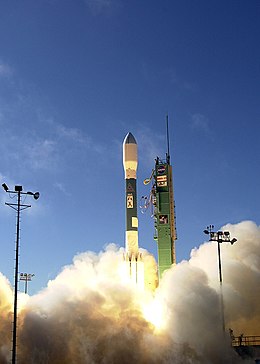USA 193

Delta II launching USA-193, Vandenberg Air Force Base, 2006
|
|
| Operator | US National Reconnaissance Office |
|---|---|
| COSPAR ID | 2006-057A |
| Mission duration | Communications lost after orbit achieved |
| Spacecraft properties | |
| Launch mass | 2,300 kilograms (5,100 lb) |
| Start of mission | |
| Launch date | 14 December 2006, 21:00:00 UTC |
| Rocket | Delta II 7920-10 |
| Launch site | Vandenberg SLC-2W |
| End of mission | |
| Disposal | Destroyed by ASAT |
| Destroyed | 21 February 2008 |
| Orbital parameters | |
| Reference system | Geocentric |
| Regime | Low Earth |
| Perigee | 242 kilometers (150 mi) |
| Apogee | 257 kilometers (160 mi) |
| Inclination | 58.48 degrees |
| Epoch | 21 February 2008 |
USA-193, also known as NRO launch 21 (NROL-21 or simply L-21), was a U.S. military reconnaissance satellite (radar imaging) launched on 14 December 2006. It was the first launch conducted by the United Launch Alliance. Owned by the National Reconnaissance Office (NRO), the craft's precise function and purpose were classified.
The satellite malfunctioned shortly after deployment, and was intentionally destroyed 14 months later on 21 February 2008, by a modified SM-3 missile fired from the warship USS Lake Erie, stationed west of Hawaii. The event highlighted growing distrust between the U.S. and China, and was viewed by some to be part of a wider "space race" involving the U.S., China, and Russia.
It was the first launch of United Launch Alliance since formed in December 2006, and first Delta II launch since ULA acquisition.
USA-193 was part of the NRO's Future Imagery Architecture, which was begun in 1997 to produce a fleet of inexpensive reconnaissance satellites, but has become the agency's most spectacular failure. USA-193 was initially developed by Boeing, which won the contract in 1999, beating out Lockheed Martin with proposals for innovative electro-optics and radar. But after cost overruns, delays, and parts failures, NRO sent the contract to Lockheed, which built USA-193 around the Boeing radar design. Lockheed Martin and Boeing both supported the launch, the first in the joint effort known as the United Launch Alliance.
USA-193 weighed about 5,000 pounds (2,268 kg), with a body thought to be 15 feet (5 m) long and 8 feet (2 m) wide, estimates based on the maximum Delta II payload. With the radar antenna extended, USA-193 was about the size of a basketball court (~30 x 15m).
...
Wikipedia
